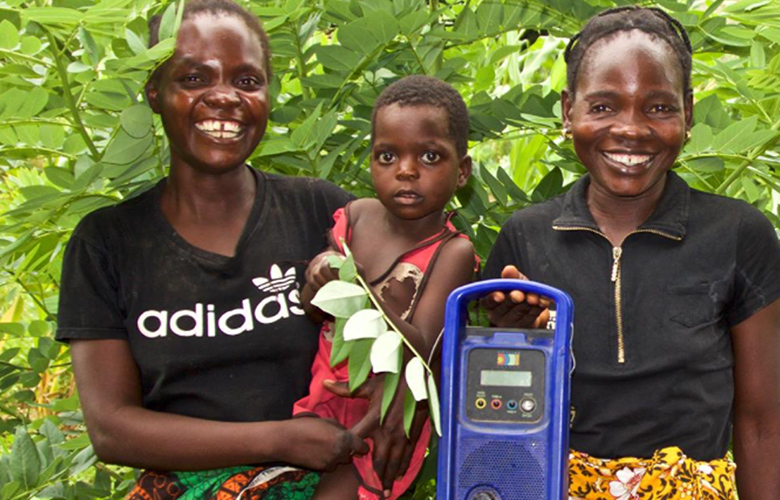A Radio-Based Approach to Learning during COVID-19
Radio may be the best way to reach students—during the pandemic and perhaps beyond.

With an estimated 90 percent of all students unable to attend school in person because of the COVID-19 pandemic, many countries are using distance learning methodologies to reach all their students. Interactive audio instruction (IAI), a technology pioneered by EDC, is one such method.
Since the mid-1980s, IAI has been used to deliver high-quality education to students in impoverished and remote communities around the world. In an IAI classroom, children interact with each other and with their ‘audio’ teacher during each broadcast. Pauses are also built into the recordings so children have time to answer questions and perform tasks. This stands in contrast to classic radio education, where students are expected simply to sit and listen to a lecture.
EDC’s Simon Richmond and Rachel Christina have both developed and implemented IAI programs in Africa, Asia, and Central America. They discuss why IAI makes so much sense now and why ministries of education should consider implementing it for the long term.
Q. What is it about IAI that makes it such a powerful learning tool?
Christina: Research clearly tells us that children who are engaged in their own learning do much better in the classroom. IAI incorporates best practices for creating active, student-centered teaching and learning. The interactivity and the quality of engagement are high. Students are singing; they’re speaking; they’re playing games; they’re problem-solving. Students also enjoy the lessons, which are directly relevant to their daily lives.
Richmond: Right. There’s no other system like it, short of having live instruction from a highly skilled and organized teacher. IAI also supports teachers as they do their jobs. It provides teachers with just-in-time guidance to help them teach better. In many of the countries where we have implemented IAI, the teachers we are working with didn’t experience good teaching when they were students themselves. They have never seen best practices modeled. IAI is one of the only ways to walk teachers through child-centered approaches and provide live accompaniment for them. And the research shows that this approach is transformative.
Q. We are living in a time now where many students are out of school because of COVID-19. What are the advantages of using IAI while parents and caregivers are responsible for helping students learn?
Christina: IAI is appropriate now because, relatively speaking, very few people worldwide have access to a computer to be able to participate in distance learning. Radio, on the other hand, has an enormous penetration globally. Broadcasting over the radio makes it possible for everyone to access programming. Because interactive audio is scripted and the radio teacher is guiding them through the lesson, parents or caregivers can help without feeling the full burden of homeschooling their children. The radio teacher is guiding you through what you’re doing. It’s like having another adult in the room. And that adult is always positive, always encouraging, always assuming that you’re getting it right so that you feel safe trying it out.
Q. So if a ministry of education is interested in starting up IAI programming right now, what would they have to do?
Christina: EDC has 30 years’ worth of programs in a variety of languages that were developed in a range of contexts. So the first thing that policymakers or educators can do is to see whether an existing program fits for them in terms of language, grade level, and subject matter, or if there is something that could be quickly adapted. It will be much easier to get quality programming working with something that already exists rather than having to start from scratch.
Richmond: And then once they have the content, they need to find ways to disseminate it. That means telling families that a new service is coming out on the airwaves, on this channel, at this time. Families also need to be told how to convert some living space into a classroom, who needs to be in the room supporting their child, and what learning materials they need to have on hand. We have already written up guidance on how to prepare families. After that, it’s really up to parents to take and use the programs the best they can.
Christina: Right now, EDC has teams that are working with governments on how to use our programs and how to get learning opportunities out to kids as quickly as possible. Of course, we are also thinking about what’s next, too, and looking for ways to sustain and promote the resiliency of education systems for the long term.
Q. Much of EDC’s IAI work has taken place in Africa and Central America. Do you see an opportunity for IAI in the United States as well?
Richmond: I do. One thing I’m seeing here in Oregon, where I live, is that the high schoolers are all on Zoom calls with their teachers, but the primary school kids are being sent worksheets. How do you engage a bunch of first graders with those? There’s a strong case for use of radio here in the U.S. at the primary level, because it’s scripted content that uses engaging stories and games and activities that kids are going to be interested in.
Christina: It’s also worth noting that here in the United States, we’re seeing enormous challenges with students not having access to the infrastructure or the equipment they need to keep up with distance education that’s offered online. So it’s not unreasonable to consider radio-based education here. I have also noticed that radio creates a kind of social community around learning, which could be really helpful now when communities are physically distancing.
Q. The sheer scope of this pandemic is prompting many to ask what education could look like in the future. Do you think ministries of education should be thinking about using radio for the long term?
Richmond: I would love to see custom programming developed for every country. This experience has taught us that every system needs an audio component in their back pocket— something they can roll out for unforeseen circumstances, like earthquakes, hurricanes, or the next pandemic. There are always times when education systems are shut down, so why do we always have to scramble?
Christina: I agree. Maintaining that continuity of learning is so important. I think a lot of countries are realizing right now that interactive audio instruction can deliver that continuity with a high degree of quality. That way, as Simon said, if you have a similar shock to the system, you’ve got this educational package that can continue to provide support to students at home. And you don’t have to go back and try to retrofit a face-to-face curriculum to a distance learning model in the middle of a disaster.




